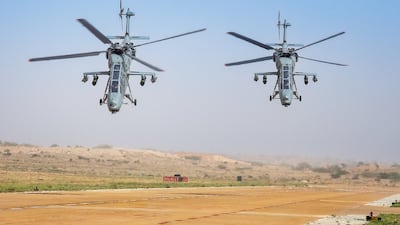The Indian Air Force took delivery of the country’s first domestically produced light combat helicopter on Monday, in the latest boost to India’s defence industry.
The Prachand — Hindi for fierce — was developed by state-run aerospace major Hindustan Aeronautics and designed for deployment in high-altitude regions.
Weighing 5.8-tonnes, the twin-engine helicopter can carry a range of missiles and is equipped with armoured-protection systems, night attack capability and crash-resistant landing gear.
It can be used in combat search-and-rescue operations, assaults on enemy air defences and counter-insurgency operations, said officials.
The Prachand can take out armoured vehicles on the ground using air-to-surface anti-tank munitions and drones with air-to-air missiles.

Defence Minister Rajnath Singh said the Prachand entering service was a “momentous occasion” for India.
“The induction of indigenously developed light combat helicopters will enhance our capability and will boost defence production,” Mr Singh said at the induction ceremony at western Jodhpur Air Force base.
It is “the only attack helicopter in the world that can land and take off at an altitude of 5,000 metres”, said CB Ananthakrishnan, chairman and managing director of Hindustan Aeronautics.
He said the Prachand “is indigenous and state of the art — one of the best combat flying machines in the world”.
The Cabinet committee on security, chaired by Prime Minister Narendra Modi, approved the procurement of 15 machines in March, at a cost of more than 40 billion rupees ($489 million).
Ten were allotted to Indian Air Force, with five for the Indian Army.
India has been steadily increasing its defence manufacturing capacity, under its ambitious Make In India initiative.
The country is among the world’s largest defence equipment importers, but has bought less in recent years, as it expands its domestic military manufacturing industry.
Last month, the country cleared the development of Tejas Mark-2 – an advanced version of its indigenous multi-role combat aircraft – and pledged to spend an additional 65bn rupees ($794m) on prototypes, testing and certification.


